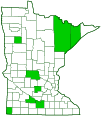waxy leaf meadow-rue
(Thalictrum revolutum)
Conservation • Wetland • Description • Habitat • Ecology • Use • Distribution • Taxonomy
Conservation Status |
|
|||||||
| IUCN Red List | not listed |
|||||||
| NatureServe | NNR - Unranked SNR - Unranked |
|||||||
| Minnesota | not listed |
|||||||
Wetland Indicator Status |
||||||||
| Great Plains | FACW - Facultative wetland |
|||||||
| Midwest | FAC - Facultative |
|||||||
| Northcentral & Northeast | FAC - Facultative |
|||||||
Description |
||
Waxy leaf meadow-rue is a 3′ to 7′ tall, erect, perennial, foul-smelling forb that rises from rhizomes. Staminate flowers (male) and pistillate flowers (female) are borne on separate plants. It often forms colonies. Stems are erect, stout, hairless, and covered with a whitish, waxy coating (glaucous). They are occasionally branched in the upper half. They are green when young becoming reddish purple with maturity. The leaves are alternate. Lower stem leaves are on leaf stalks, middle and upper leaves are stalkless. They are 3 or 4 times ternate—divided into 3 main divisions (ternate), each division further divided into 3 segments (biternate), each segment further divided into 3 leaflets (triternate), or once more divided. The leaflets are leathery, variable in shape, ⅓″ to 2⅓″ long, ¼″ to 2″ wide, 1 to 5 times, but usually no more than 2¾ times, as long as wide. The larger leaflets are divided into 2 to 5 but usually 2 or 3 lobes. The lobes are untoothed or occasionally have a few additional teeth. Smaller leaflets may be unlobed. The margins are rolled backward toward the underside. The upper surface is hairless. The lower surface is covered with whitish glandular hairs making it whitish and waxy in appearance, and has a network of conspicuous, prominent (raised) veins. When crushed the stems and leaves produce a skunk-like smell. The male inflorescence is a large, open, showy, branched cluster at the end of the stems and branches. It is up to 2′ tall and 1′ wide. Male flowers have usually 4 but up to 6 whitish petal-like sepals. There are no petals. They droop at the end of short stalks. The sepals often drop off early leaving about 12 stamens with white filaments and yellow anthers. The flowers do not produce petals or nectar to attract insects. They are wind pollinated. The fruit is an achene a little over ⅛″ long. |
||
Height |
||
3′ to 7′ |
||
Flower Color |
||
Whitish |
||
Similar Species |
||
Purple meadow-rue (Thalictrum dasycarpum) has hairy but not glandular lower leaf surfaces. The foliage is not skunk-scented. Early meadow-rue (Thalictrum doicum) is a much smaller plant, 12″ to 28″ at maturity. All leaves, including middle and upper leaves, are on long stalks. The leaflets have 3 to 12 often round-toothed lobes. The flowers bloom earlier, April to May. It is found in woodlands, not prairies. |
||
Habitat |
||
Dry. Prairies, thickets, open woods. Full to partial sun. |
||
Ecology |
||
Flowering |
||
June to July |
||
Pests and Diseases |
||
|
||
Use |
||
|
||
Distribution |
||||
|
Sources |
|||
| 4/23/2023 | ||||
Nativity |
||||
Native |
||||
Occurrence |
||||
Uncommon |
||||
Taxonomy |
|||
| Kingdom | Plantae (Plants) | ||
| Division | Tracheophyta (Vascular Plants) | ||
| Subdivision | Spermatophytina (Seed Plants) | ||
| Class | Magnoliopsida (Dicots) | ||
| Superorder | Ranunculanae | ||
Order |
Ranunculales (Buttercups, Poppies, and Allies) | ||
Family |
Ranunculaceae (Buttercup) | ||
| Subfamily | Thalictroideae (columbines and meadow-rues) | ||
Genus |
Thalictrum (meadow-rues) | ||
Subordinate Taxa |
|||
Synonyms |
|||
Thalictrum amphibolum Thalictrum hepaticum Thalictrum moseleyi Thalictrum revolutum var. glandulosior |
|||
Common Names |
|||
purple meadowrue skunk meadowrue waxy leaf meadow-rue waxy meadowrue waxyleaf meadowrue waxyleaf meadow-rue wax-leaved meadowrue |
|||
Glossary
Achene
A dry, one-chambered, single-seeded seed capsule, formed from a single carpel, with the seed attached to the membranous outer layer (wall) only by the seed stalk; the wall, formed entirely from the wall of the superior ovary, does not split open at maturity, but relies on decay or predation to release the contents.
Glandular hairs
Hairs spread over aerial vegetation that secrete essential oils. The oils act to protect against herbivores and pathogens or, when on a flower part, attract pollinators. The hairs have a sticky or oily feel.
Glaucous
Pale green or bluish gray due to a whitish, powdery or waxy film, as on a plum or a grape.
Ternate
Refers to leaves that are divided into three leaflets or sections.
Visitor Photos |
|||||
Share your photo of this plant. |
|||||
| This button not working for you? Simply email us at info@MinnesotaSeasons.com. Attach one or more photos and, if you like, a caption. |
|||||
|
|||||
MinnesotaSeasons.com Photos |
|||||
|
|||||

Slideshows |
||

Visitor Videos |
|||
Share your video of this plant. |
|||
| This button not working for you? Simply email us at info@MinnesotaSeasons.com. Attach a video, a YouTube link, or a cloud storage link. |
|||
Other Videos |
|||

Visitor Sightings |
|||||
Report a sighting of this plant. |
|||||
| This button not working for you? Simply email us at info@MinnesotaSeasons.com. Be sure to include a location. |
|||||
|
|||||
MinnesotaSeasons.com Sightings |
|||||
|
|||||

|
Created: Last Updated: © MinnesotaSeasons.com. All rights reserved. |
